![]()
![]()
![]()
Use LEFT and RIGHT arrow keys to navigate between flashcards;
Use UP and DOWN arrow keys to flip the card;
H to show hint;
A reads text to speech;
51 Cards in this Set
- Front
- Back
|
Cell membrane (Plasma membrane) |
A barrier that separates life from nonlife. (2) Enclosed environment allows reactions to occur more frequently. Added efficiency. |
|
|
Lipid |
A carbon-containing compound that is found in organisms. Characterized largely as: |
|
|
Nonpolar |
Lipids have mainly C--H bonding which means electrons are shared equally. Dissolve in nonpolar organic compounds (Like with Like). |
|
|
Polar |
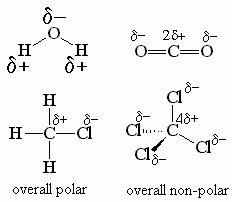
Electronegativity difference between atoms where one "hogs" the electrons owing to a partial negative charge, and a partial positive for the other. |
|
|
Hydrocarbon |
Molecule containing only carbon and hydrogen. Characterized as: (1) Nonpolar (2) Hydrophobic |
|
|
Fat (Triglyceride or Triacylglycerol) |
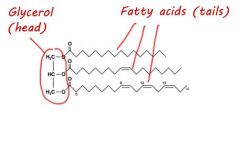
A lipid consisting of three fatty acid molecules joined by ester linkages to a glycerol molecule. |
|
|
Fatty Acid |

A lipid consisting of a hydrocarbon chain bonded at one end to a carboxyl group. Used to store energy. |
|
|
Glycerol |

Three carbon molecule that forms backbone of most phospholipids and fats (pg 86). |
|
|
Ester linkage |
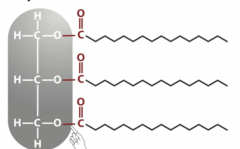
Linkage area for glycerol molecule and fatty acid tail. |
|
|
Steroid |
A family of lipids distinguished by the bulky, four ring structure. Differ by their functional group or side chain (pg. 87, fig 6.4a) |
|
|
Cholesterol |
A sterol that is present in cells and surrounding fluid. Functions: (2) acts as a precursor molecule for steroid hormones. |
|
|
Amphipathic |
"Duel sympathy" |
|
|
Micelle |
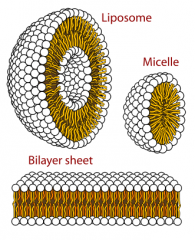
A tiny droplet of hydrophilic heads and hydrophobic tails that interact in a ball. |
|
|
Lipid bilayer |

Created when two sheets of lipid molecules align. |
|
|
Liposome |
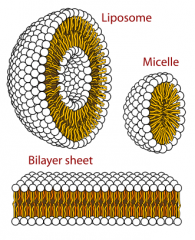
A minute spherical sac of phospholipid molecules that enclose a water droplet. Sometimes made artificially to deliver drugs. |
|
|
Planar bilayer |
Artificial lipid bilayer made to study permeability. |
|
|
Permeability |
The tendency to allow a given substance to pass through a membrane. |
|
|
Selective permeability |
Means that some substances can cross easier than others, owing to the number of transporters and phospholipid structure (Short unsaturated phospholipids have higher permeability that long saturated ones) |
|
|
Unsaturated lipid |
One or more carbons in the chain are held together by double bonds. These bonds result in kinks in the structure. |
|
|
Unsaturated Vs Saturated structure |
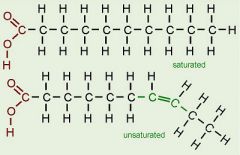
|
|
|
Saturated |
Hydrocarbons are all held together as single bonds. Long, strait chains. |
|
|
Wax |
Extremely long hydrocarbon tails. Characterized as solids at room temp. |
|
|
Oil |
A polyunsaturated fat that is a liquid at room temp. |
|
|
Membrane fluidity |
Refers to the viscosity of the lipid bilayer of a cell. Viscosity is determined by how packed together the lipids are. |
|
|
Diffusion |
Movement of molecules and ions that result from their kinetic energy (Ex: pool balls being vibrated on a table will eventually create distance between them). |
|
|
Solutes |
The minority substance in a mixture. |
|
|
Concentration gradient |
A difference in solute concentration between a semi-permeable membrane. Net movement from high--->to low concentration. |
|
|
Equilibrium |
Molecular movement occurs at the same rates because they are equally as likely to move in any directions. |
|
|
Osmosis |
Occurs only when solutions are separated by a membrane that permits water to cross. |
|
|
Hypertonic |
A comparative term that is used to describe the cell in relation to the outside or vice versa. If a cell is hypertonic (meaning high solute concentration = low free water), water moves into the cell and it swells. |
|
|
Hypotonic |
If the solution inside the membrane have low concentration of solutes than the exterior (High [solute], low [free water]). Water leaves the interior and the cell shrinks. |
|
|
Isotonic |
Solution concentration is equal on both sides, the cell maintains its size. |
|
|
Fluid Mosaic model |
A model of the cell membrane which highlights the flexible nature of lipids and the interspersed protein channels that dot the surface. Some proteins continue through the membrane and act as channels. |
|
|
Freeze Fracture electron microscopy |
A technique used to observe the cell membrane by freezing the cell and breaking it open. |
|
|
Scanning Electron Microscopy |
A microscope that produces images of the surfaces of objects by reflecting electrons from a specimen coated with a layer of metal atoms. |
|
|
Integral (transmembrane) protein |
Proteins that extend through the plasma membrane. |
|
|
Peripheral protein |
Proteins that do not pass through membrane. |
|
|
Gel electrophoresis |
A method of separating substances, especially proteins, and analyzing molecular structure based on the rate of movement of each component in a colloidal suspension while under influence of an electrical field. |
|
|
Facilitated diffusion (passive mediated diffusion) |
Process of spontaneous passive transport (as opposed to active transport) of molecules or ions across a biological membrane via specific transmembrane integral proteins. |
|
|
Passive transport |
The movement of biochemicals and other atomic or molecular substances across cell membranes. Unlike active transport, it does not require an input of chemical energy, being driven by the growth of entropy of the system. |
|
|
Active transport |
The movement of ions or molecules across a cell membrane into a region of higher concentration, assisted by enzymes and requiring energy. |
|
|
Secondary active transport |
Transport of an ion or molecule in a defined direction that is often against its electrochemical gradient, in company with an ion or molecule being transported along its electrochemical gradient. |
|
|
Channel protein |
A protein that forms a pore in a cell membrane. Only admits certain types of ions or molecules. |
|
|
Ion channel |
A type of channel proteins that allows certain ions to diffuse across a plasma membrane down its electrochemical gradient. |
|
|
Gated Channel |
A channel protein that opens and closes in response to a specific stimulus, such as the binding of a particular molecule or a change in voltage across the membrane. |
|
|
Carrier proteins |
Carrier proteins facilitate the diffusion of different molecules, while channel proteins are involved in the movement of ions, small molecules, or macromolecules, such as another protein, across a biological membrane. |
|
|
Electrochemical gradient |
Is a gradient of electrochemical potential, usually for an ion that can move across a membrane. The gradient consists of two parts, the electrical potential and a difference in the chemical concentration across a membrane. |
|
|
CFTR |
Short for cystic fibrosis transmembrane conductance regulator. |
|
|
Cystic fibrosis |
Common genetic disease in humans of Northern European decent. Affects cells that secrete mucus. In people affected the mucus is thick and concentrated and can clog passageways in organs like the lungs. |
|
|
Aquaporins |
Channels that specifically move water only. Moves across cell membrane 10x faster than without. |
|
|
Glut-1 |
Transports glucose into the cell through a conformational change that responds to when glucose binds. |

